Ijraset Journal For Research in Applied Science and Engineering Technology
- Home / Ijraset
- On This Page
- Abstract
- Introduction
- Conclusion
- References
- Copyright
The System for Human Temperature Detector and Pulse Analyzer
Authors: Kartik Pisudde, Prajakta Dharpure, Rutucharya Bagde, Rajat Adhaye, Ganesh Bobade, Pratiksha Khandare
DOI Link: https://doi.org/10.22214/ijraset.2022.44499
Certificate: View Certificate
Abstract
An ongoing framework for assessing patient health through a remote sensing system using soft registrations is a new concept that has already been introduced in developed countries in recent years. The Physical Area Network is made using integrated sensors that collect and monitor parameter and physical development. The device provides a number of auxiliary power that satisfies the patient\'s live request. In addition, it uses a variety of sensors to detect important symptoms of patients, including heartbeat and fever. The transmission of these patient records via the web is done sensor and Arduino on the web server where the data is stored. In addition, it will display patient-patient status predictions based on a combination of all patient records. The generated report will be displayed in the web application. With the help of a web application both doctor and patient can have real-time communication. The prototype was used successfully when data was received and displayed. The aim is to build a prototype to help developing countries as they have not yet reached medical expertise and appropriate diagnosis and timely treatment. Exploitation of these 2 technologies we tend to create a school application to stay in the U.S. safe from corona virus and its symptoms. it will be a qualification app that everyone can use by installing it on mobile phones, tablets, laptops and desktops, etc. In the future, some engineers may remove this project by adding certain response features to covid-19 issues.
Introduction
I. INTRODUCTION
Advances in medical technology have brought about rapid changes in the e-health care system. An effective e-health monitoring model can be of great help to people in developing countries. The technology provides assistance to physicians to better diagnose and treat non-invasive patients as it is sometimes necessary to provide a cure or treat patients who are unfortunately unlucky and untreated. Today advanced medical technology has a positive impact on our personal lives. This helps to improve and save countless lives around the world. Medical technology is a broad field of practice in which remodeling plays a vital role in improving health. Body Area System is identified by IEEE 802.15 as, ‘a level of communication designed for low power and mechanical function, within or near the human body to provide a variety of applications including medical, consumer electronics / personal entertainment and more’. The wireless body structure is a major blood technology that operates quickly and provides effective medical care. The point of the remote body system is to promote regular recording and testing of male well-being and long-term communication exchanges. The medical center available in developing countries allows patients to undergo physical examination for a medical examination or to have their patient's needs adjusted for regular checkups. The process is consistent and time consuming. Today the remote sensory system allows patients to control their daily routine anywhere. Therefore, in support of real-time patient health monitoring, in this project we promote regular personal health monitoring by transmitting human body temperature and heart rate data using a sensor and Arduino on a web server accessible to both physician and patient. Possible use of a remote e-health framework helps with constant monitoring, critical monitoring to avoid another critical situation based on a patient’s ongoing record. According to the American Heart Association, treatment in the first 12 minutes can bring about a positive effect of about 45% to 60%. It is noteworthy here that the proposed design is intended for everyone including patients to keep a record of their general health status and create a dynamic space between physician and patient by assessing the ongoing well-being of those.
Today, the use of technology to improve the quality of life has become quite common in today's society. When technology is aimed at improving the quality of life, it refers to the Internet of Things. In a hospital health care monitoring system it is necessary to regularly monitor the physiological parameters of the patient. In general, ward examinations do not really recognize ongoing life limits and therefore patient recurrence is rare. To overcome such a problem Embedded technology will be used to monitor the patient's condition more easily. A remote specialist can monitor a patient's condition to save lives and provide a doctor with a prescription. This program will assist in finding a patient to be treated in that hospital building. In an emergency we automatically know the list of available doctors and their environment with the help of the Kiosk screen at the entrance to that hospital. The program provides automated medical recommendations on a first-come,
II. LITERATURE REVIEW
Internet of Things Technology and Styles for Health Care Services.
Or MM. AbdElnapi, AbdeImageid A. Ali, Nahla F. Omran, Fatma A. Omara.
Online Surveys of Technology and Styles of Health Care Services. 2018 International Conference on New designs in pc Engineering (ITCE 2018).
Summary: This paper provides an overview of important medical IoT treatments in addition such as a review of the current state of IoT styles, as well as the technologies required for attention centers. The conclusion is taken from the current stage of development and open problems.
RFID verification schemes for online items within the health care facility.
Debiao he and Sherali Zeadally.
Analysis of RFID authentication systems for online objects within the health care area of ??the eliptic curve cryptography. IEEE net for JOURNAL ITEMS, VOLUME. 2, NO. 1, Feb 2016.
Briefly: The author of this paper, discusses the security requirements of RFID authentication systems, and in particular, presents a review of the ECC-based RFID authentication systems regarding performance and safety. and most of them will meet all safety requirements and work satisfactorily, we have found that there are recent ECC-based assurance systems that work in the context of health care in terms of functionality and safety.
Alexandru Archip, Nicolae Botezatu, Elena Serban, Paul-Corneliu Herghelegiu, Andrei Zala
IoT Remote Patient Watch System. 2016 17th International Carpathian International Conference (ICCC).
Summary: The author in the middle of this current paper outlines the steps taken to style and create a cost-effective visual system model. The program aims to produce cellular support to facilitate faster and more immediate medical interventions in emergencies and to develop a dedicated concentration of low-energy sensor, SpO2, temperature and movement. The connectivity of those sensors depends on the IoT model: the central management unit introduces RESTful-based online interaction that ensures anonymous platform behavior and offers a variety of thanks to the integration of new components.
III. METHODOLOGY
This chapter of the work explains how it will work, the theme and its objectives. In this project, we will develop the field of application for compatible qualifications for candidates due to the currently dangerous COVID-19 epidemic. By abusing our computer-based application data we will prevent the corona virus from spreading to the environment.
We have a habit of not being able to prevent all the symptoms of corona infection by abusing computer-based technology but it will prevent some symptoms from spreading to humans.
We often use two technologies to try and implement our project namely face detection and critical signal analysis. by abusing these two technologies we will provide the answer to the two main symptoms of corona infection namely the natural reflex within the nose and magnification of the vital sign to prevent the main symptoms of covid we often use the mask detection process i.e. to find a person's face whether you are playing the mask or not during this process we have a habit of using the language of advanced python programs and it is used to identify the individual. we often use a combination of QR code directly linked to information. currently to live vital signal we usually use Arduino (IoT) system heat exchanger. And by writing codes we have a habit of using dot-editing language wherever secondary covid symbols are formed.
Analyze, use and store oracle-abuse information in our project. 3.1. Strange explanation: The first case of the corona virus was confirmed in the Republic of India on 30/01/2019 which spread from Wuhan, China. As a result of covid cases the fast-growing square in the Republic of India and many square people are being harassed by them for not following the guidelines of the United Nations (World Health Organization) so major pharmaceutical companies around the world are developing coronavirus vaccines to protect people. However, we will prevent the virus from spreading to our country through a police investigation into its symptoms using a computer-based program that is very helpful to people.
- And detecting the temperature of maltreatment and heart rate monitoring technology.
- Using a heat detector somewhere to live an important user signal.
IV. PROPOSED SYSTEM
In this chapter we can discuss our project used to monitor heart rate and temperature. The main agenda of our project is to reduce the level of symptoms of corona infection.
Our proposed project plan has three key components provided below:
- Entry gate.
- Data base of college.
- Hod of college .
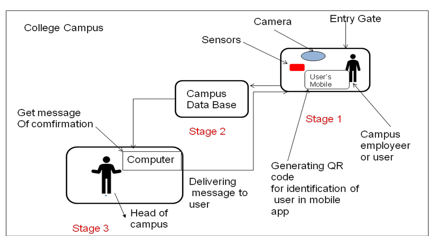
A. Proposed system for college
- Entry Gate: Within unlocking, the user can log in from entree. Initially before entering the gate the user must perform the registration process (user details such as name, mobile type, address, semester, etc.) and malfunction the in-app request and upon completion of the registration process the user will receive his most important QR code. . -QR on the web camera in a continuous way i.e. mask detection. In the process of getting a mask scans the QR code and when scanning the code the user has to show his face. When you do that the system checks the user who plays the mask or not. When a user plays a mask it will carry a non-stop path if not. During this procedure the user should immediately check his or her body temperature to obtain a thermometer kit located somewhere on the front door. After performing the technique the temperature monitoring method checks that the temperature is within the traditional range or above its limit. If an important signal is common then the user will tolerate a non-stop approach in one step or else the user should stop..
- Database of Collage: When the completion of the main part of the user information to obtain the mask and analysis of key features is transferred to the school field information. That information further goes to the top of the school field on their computer using the method of the next third party.
- Main Head of Campus: During the second half process, the school pinnacle may receive a confirmation message regarding the user's low and secondary position on his or her computer. The school curator can then send a message to his or her computer on the user's mobile device which means "You have access to college". The performance of all classes depends on the user and is restarted with the user.
V. PERFORMANCE AND ASSURANCE
This chapter of the project describes the look of the system, the implementation process, as well as the multilingual language.
A. Design
- System Architecture
We have outlined below the structure of a complete descriptive system but it works to be fully aware of it.
The system structure will be divided into three main modules.
- Administrator module: - WHO controls the system, eliminates errors and resolves problems while using the system.
- User module: - This module performs all the functions performed by the administrator.
- Head of the field module: - This module has the body and management capabilities.
2. Administrator Module
- The manager can also manage the program activities or activities performed by him within the program.
- The administrator should use the system while not tolerating errors suggesting that he or she can use the system without fail at all because he or she is integrating part of the savings into it. And no area unit is no difficulty while harassing the system
- The administrator will manage student and user guest information and this module will add, remove, update and reset student information and user information by taking student and user permissions.
- The director module will handle all information functions which means it has full control of the information.
- Inside the information, it contains all the key data points for student and user visitors. And their information history suggests that input and output are valid.
- The administrator will issue a warning or permission to his system using the website through the instant messaging service to the reader or user to perform various tasks.
3. User Module
- Within the user module, coed or user must generate an AN account within the system by adding his / her details such as student id, name, email id, mobile grade, semester, etc.
- If you add all this data the reader or user will get a QR code generated by the module.
- And the payer or user must scan his QR code before the camera
- When scanning a QR code the system checks whether it is correct or not. If the QR code found the correct coed or the user will go the next route, otherwise it will not.
- The next step is the coed or user should show his face in front of the camera to attract face detection which raises the test to see if the person is playing the mask or not. If the coed plays the mask then he will continue the work, otherwise he can not.
- Then there is the next step of blood pressure analysis that suggests checking the user or student temperature to be normal or higher with LM35 Arduino and Arduino temperature device connected to the system via USB port.
Student or user temperatures area unit calculated in Gabriel Daniel Fahrenheit and your details of each the facial expressions and blood heat of the coed or user area unit sent on to the program information.
B. Head of the Field Module
- This module has field and management controls and system check standing. The field head can take action if a slip has been created within the system by the user. He will thus send a message to the user via admin and so admin through the information.
- Otherwise all operations of the system user or student will be performed completely with none interruption
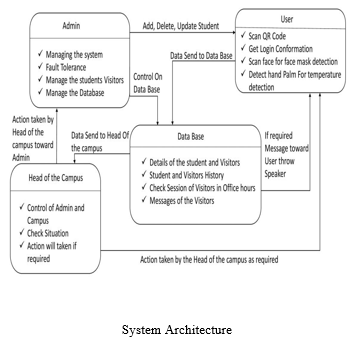
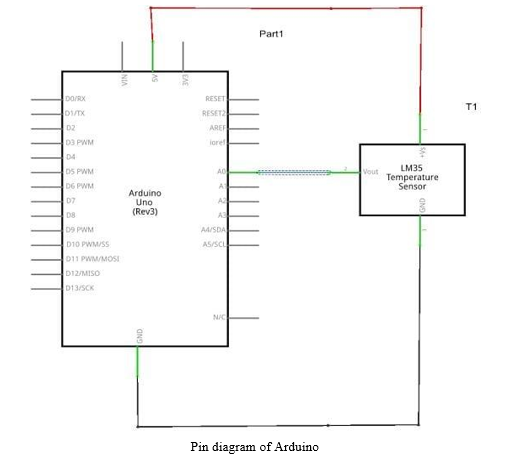
Pictured above is a drawing of an Arduino Uno kit kit connected to the LM35 heat sensor. There are twenty-nine pins in the Arduino Uno kit and three pins in the LM35 temperature sensor. The duties of each deputy are as follows;
• D0 / RX: - Arduino Uno has a single main controller and a single controller that acts as a USB-to-serial interface. D0 / RX connectors for the main controller are directly connected to 1k resistors in other "controller" connectors.
• D0 / TX: - 1 digital PIN used for serial communication.
• D2: - This pin can be adjusted to cause a low value disturbance, an ups and downs, or a change in value.
• PWM (3,5,6,9,10,11): - Provides 8-bit PWM output and analog function Write () and PWM output is only available on 9,10 and 11 pins .
• SPI: - 10 (SS), 11 (MOSI), 12 (MISO), 13 (SCK): - These anchors support the SPI connection, which even provided small computer hardware is not currently available in Arduino language.
• VIN: - The input voltage of the Arduino board when using an external power source. You can power it with this pin, or if you give it a power jug, access it with this pin.
• 5V: - Controlled power supply used to power a small controller and other components on the board. This can come from the VIN via the controller or USB.
• 3V3: - 3.3 volt made FTDI board on board.
• GND: - Low pins.
• AREF: - Reference analog input power used by Analog Reference ().
• Reset and reset 2: - Bring these lines DOWN to reset the controller or press the reset button in the columns that block that board.
• A0 to A3: - These are the analog pins that are used to turn on the LED.
• A5 / SCL and A4 / SDA: - These are in the analog texts A4 and A5 used for I2C performance.
• N / C: - Means there is no cord in that pin.
• Vout: - Outgoing voltage
C. Interfacing diagram for LM35 and Arduino Uno kit
The following figure is a link between the LM35 and the Arduino Uno kit. As shown in the picture the Vout pin of the LM35 sensor sensor is connected to the Arduino Uno kit with an input pin of the A1. The analog input pin A1 takes the input from the Vout pin of the LM35 which works to detect human body temperature in Fahrenheit and then transmits the system via USB port to save data to the database.
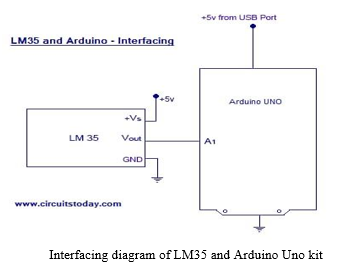
D. Flow Chart
This flowchart provides complete details of the various functions that can be performed by a system. Provides complete status from the user login function to receive a login message from a college computer theme. It also describes the step-by-step process of project flow that describes every event or activity that will take place. The following figure is a flow chart for the entire project plan.
Flowchart
- Implementation: Implementation, focused on software and hardware implementation and measures included during project implementation.
E. Hardware Requirements
- Personal Computer: This computer is assigned to the administrator itself. The administrator can manage everything with the help of the program such as program management, add, delete, delete and update the data reader or user, remove system errors, manage and manage the database, send a user or student activity message via messaging service or gateway.
- Web Camera: A webcam is a digital video device usually built into a computer and its main function is to send pictures or photos online. We use it for our project to get a face or user face detection.
- LM35 Temperature Sensor: LM35 integrated circuit heat sensor, whose output power varies depending on the body temperature of the person around it. It measures the temperature in Degree and Fahrenheit.
- Arduino Uno Kit: This kit is an open source electronic platform based on simple hardware and easy-to-use software This kit can read inputs such as a light sensor, finger button, or message and can be turned into output by entering system codes.
F. Software Requirements
- Microsoft Visual Studio: Microsoft Visual Studio is an integrated development platform (IDE) from Microsoft. It is used to improve computer programs and websites, web applications, mobile applications. Includes code editor that supports intelligence and reusable code. It also has an integrated debugger. It supports 36 different programming languages ??and allows code editor and debugger to support any editing language. Includes c, c ++, visual basic .NET, and python, etc. We use this program in our project to use modules in different programming languages.
- Visual Basic .NET: Object-based programming language used in the NET framework. It has full access to all libraries in the NET framework. We use this software in the messaging service and to create a QR code for our project.
- Python: Translated, object-focused, advanced language with flexible semantics and built into data structures combined with flexible and binding typing. It makes it a lot of fun to develop the app quickly, as well as to be used as a writing or paste language to connect something that exists together. For this reason we use python 3.7 software to scan QR code and face detection in our project.
- C ++ embedding: Also programming language focused on the object. It is more powerful than other programming languages ??because it has higher performance requirements, a more secure security system, reduced resources such as memory and CPU power. Thanks for this Language that we can access and manage Hardware directly without fail. This is the language we use for the LM35 sensor to monitor the body temperature connected to the Arduino Uno kit.
- Oracle 10g: Oracle 10g website for business grid computer,. It is a flexible and expensive way to manage data and applications. We use this website to store data for our project plan.
VI. ANALYSIS AND RESULT
A. Result
Our project is largely based on the problems associated with the symptoms of the corona virus and its operation is simple. So in our project we will see the face of the visitor wearing a mask or not and his body temperature. By following this process we will be able to tell you what kind of analysis we see in project data. While you want to design this type of program with computer hardware you will need a very small amount to build this project.
Our project can determine how we can live a normal life in this modern age which means we are actually making good moral thoughts in people’s minds.
B. Screenshots
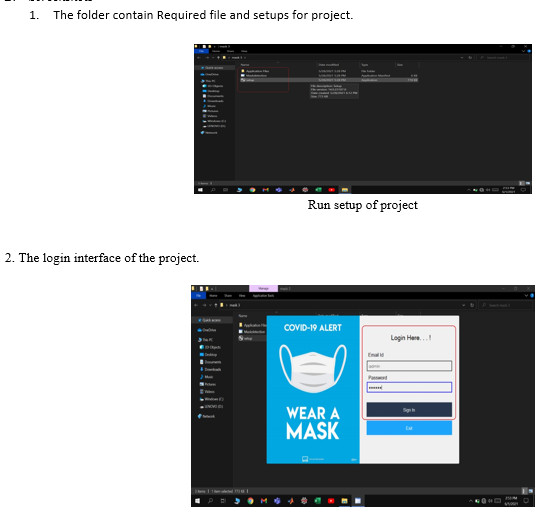
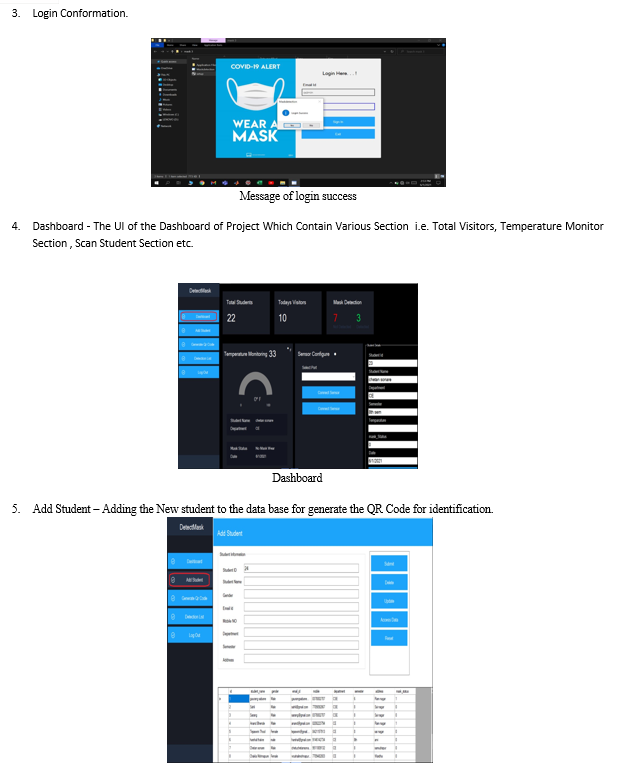

8. Visitors identification and face mask Detection.
9. Scan QR Code – Scanning visitors of QR Code by Camara for Visitors identification. SCR.No.6.12. Scan QR code process
10. Conformation of Visitors identification by callback Function in Windows PowerShell.
11. Warning gave by the administration. Then send the data to Dashboard.
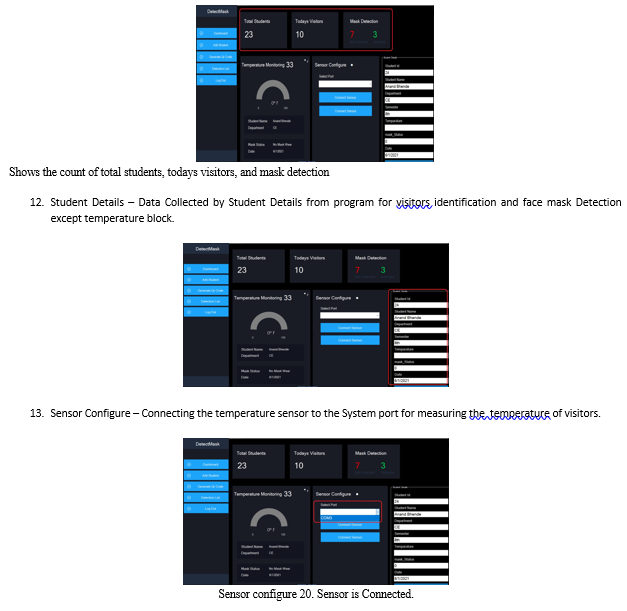
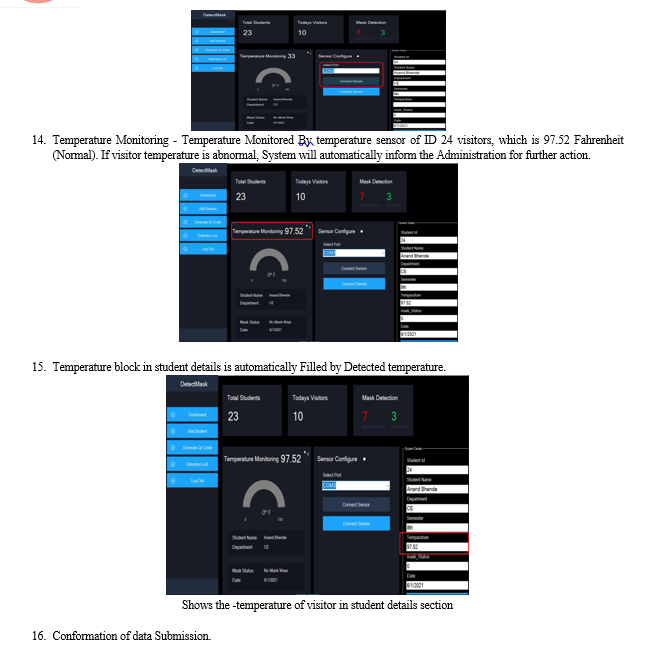
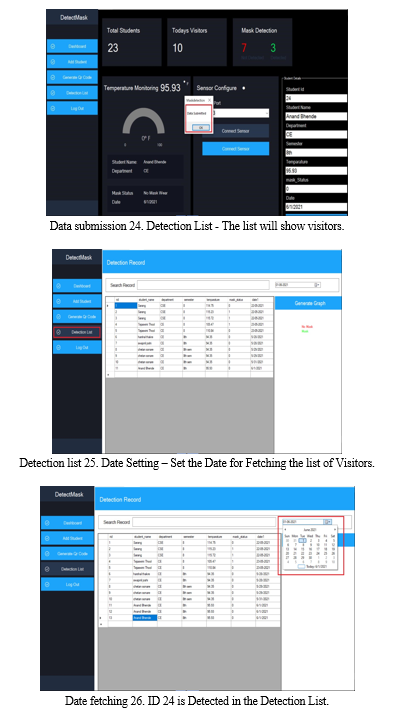

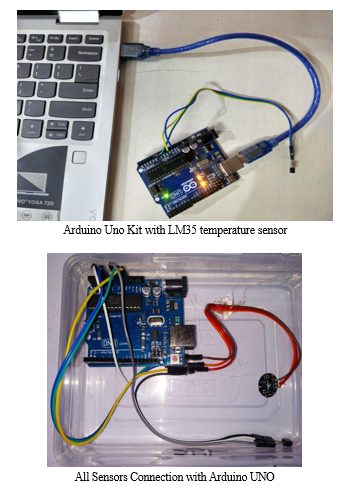
18. Analysis
In the analysis of the project we found that out of 100 people 3 out of 5 people we find have unusual temperatures.
So after finding those 3 to 5 people by the act of the administrator taken to save the rest of the people who affected those 3 to 5 people and 100 people 20% of the people who were not wearing a mask and left 80% of the people 30% not wearing a mask properly.
They wear a mask under the nose or simply apply a mask to the face without covering the nose and mouth. It means that only 50% to 60% of people wear a mask properly without 100% on campus.
VII. FUTURE SCOPE
In the next case, we will try to supplement or renew our project by using an oximeter used to measure heart rate and oxygen saturation level or blood pressure. Lowering the level of oxygen in the human body is also a major sign of the corona virus that we will try to get through this program.
Conclusion
In the next case, we will try to supplement or renew our project by using an oximeter used to measure heart rate and oxygen saturation level or body temperature. Lowering the level of oxygen in the human body is also a major sign of the corona virus that we will try to get through this program. In this project we introduce the Design System For Face Mask Detection and Body Temperature Analyzer on whether educational institutions can use this project to maintain their safety from corona symptoms by checking whether the student or user is wearing the mask properly and not with their normal body temperature or no. This program is practical, effective, and easy to work for college staff, this program will improve the negligent behavior of people and provide a good practice of following WHO guidelines to fight corona virus. The program also improves the new standard of living not only in our city but also in our country. You can use this program in your company, industry, housing community and your home and at a low cost.
References
[1] Accenture. 2020. Artificial Intelligence is the future of growth. https://www.accenture.com/in-en/insight-artificial-intelligence-futuregrowth. (2020). [Online; accessed May 20, 2020]. [2] Landing AI. 2020. Empowering companies to jumpstart AI and generate real-world value. https://landing.ai/. (2020). [Online; Accessed May 16, 2020]. [3] World Health Organization (WHO). About COVID-19. WHO. Available from URL: http:// www.emro.who.int/ health-topics/ coronavirus/questions- and-answers.html. Last access: April18, 2020. [4] P. Ubaidulla, And Sonia A¨Issa, Senior Member, Ieee, (June 2012) “Optimal Relay Selection And Power Allocation For Cognitive Two Way Relaying Networks”. Ieee Wireless Communications Letters, Vol. 1, No. 3. [5] https://www.researchgate.net/publication/341757281_Case_Study_Fighting_Covid-19_with_Tech_and_Innovation. [6] https://econlife.com/2020/05/pandemic-innovations/. [7] Aw J. The non-contact handheld cutaneous infra-red thermometer for fever screening during the COVID-19 global emergency. Journal of Hospital Infection. 2020; 104(4): 1-1.
Copyright
Copyright © 2022 Kartik Pisudde, Prajakta Dharpure, Rutucharya Bagde, Rajat Adhaye, Ganesh Bobade, Pratiksha Khandare. This is an open access article distributed under the Creative Commons Attribution License, which permits unrestricted use, distribution, and reproduction in any medium, provided the original work is properly cited.

Download Paper
Paper Id : IJRASET44499
Publish Date : 2022-06-18
ISSN : 2321-9653
Publisher Name : IJRASET
DOI Link : Click Here
 Submit Paper Online
Submit Paper Online

